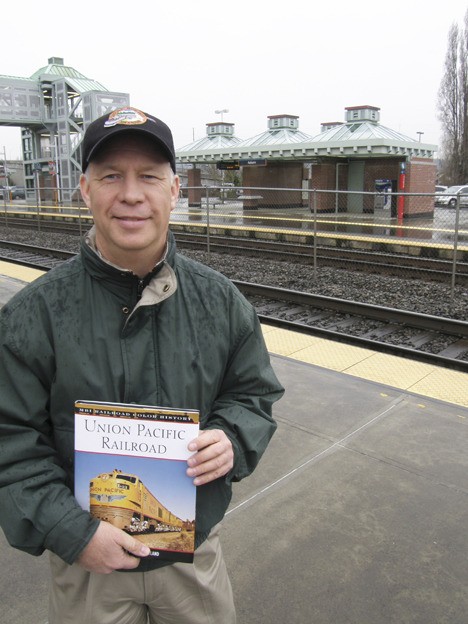What the world needs right now, a critic might say, is another coffee table book.
Joe Welsh’s 160-page, soup-to-nuts history of the Union Pacific Railroad from its inception in 1862 to current days, “Union Pacific Railroad,” Voyageur Press, 2009, might be just the book the critic has in mind.
Welsh, a transportation planner for the City of Auburn and a nationally known railroad expert, said that the aim of the book, coauthored by Kevin L. Holland of Toronto, Ontario, is to chronicle in word and photographs the rich, 148-year history of the railroad in one volume.
And that’s not easy.
“The Union Pacific is fascinating because it’s a big bad transportation company,” Welsh said. “These guys have 49,000 employees. They are a $3 billion-a year-operation. As the guy said on that film, The Fugitive: ‘This company is a monster.’”
Indeed, the book reveals that
“monster,” is the second-largest landholder in the Western United States, next to the U.S. government. Remarkably, it is the same corporate entity today it was in 1862, with the longest-standing corporate name in American history and a corporate image or colors that have remained unchanged since 1941.
Not only that, turns out that the Union Pacific Railroad was involved in every major transportation event on the ground related to railroads in the country. One of the first two railroads to form the Transcontinental Railroad, it also built the first streamlined passenger train and operated the largest steam locomotives in the country.
The book also captures the story of the first years, how it survived economic disasters like the Great Depression and its part in rail industry’s merger madness from the 1970s through the 1990s.
It is a history filled with larger-than life characters, from the legendary E.H. Harriman on down.
“Their whole history is a list of these ridiculous superlatives,” Welsh said.
Welsh called the book “a coffee table book on steroids. These books usually have a lot more information in them than your typical coffee table book. Usually, a coffee table book will have 7,000 pictures and 5,000 to 10,000 words. This is probably 30,000 to 40,000 words, so there’s a lot more detail in there about how things worked, especially as you get into the later chapters where you talk about locomotives and how the company expanded in the ’30s, ’40s and ’50s. And there’s lots of great pictures in here.”
Welsh and Holland have illustrated the book with photographs taken by the Union Pacific and shot by different rail fans, including the legendary Jim Shaugnessy.
“This is the first book that kind of packages it all up. You have Maury Klein’s two-volume set on the Union Pacific Railroad, which was the actual history of the UP, and it’s about that thick,” Welsh said. “I think there are probably five pictures in that entire book, black-and-white photographs this big, of their presidents. It’s extremely dry, and I couldn’t get through the book.
“This book popularizes the history of the railroad, so it walks the line between that sort of dry, 1,200-page recitation and the pamphleteer approach to books, which is ‘Hey, it’s got a scratch-and-sniff section, too,’” Welsh said. “So, rather than be the worst of both worlds, it’s the best of both worlds.”
Welsh added that a color portrait of a black-and-white train is not important to most people, but model railroaders, the other group that buys such books, want to know what it looked like.
“Well, it wasn’t just all black. The boiler was all washed with alkaline. Here they are, and they’ve shot their own locomotives in service. No other railroad in North America did this. No other railroad shot its own steam before it was outdated in color like these guys did. It’s just unbelievable that they recorded this. We’re talking about some really rare photography. There’s also some great shots of some passenger trains as well,” Welsh said.
“Coffee table books are dime a dozen, we just wanted to be something a little different,” Welsh said. “At a minimum, we accomplished that by accident with the photographs. This is probably the highest quality photographic book I have ever done, and I just can’t believe the quality of the images throughout the book. They’re exceptional. I was stunned when it came back from these guys.”
The book is available on Amazon.com, and at Borders and Barnes and Noble for $37.



